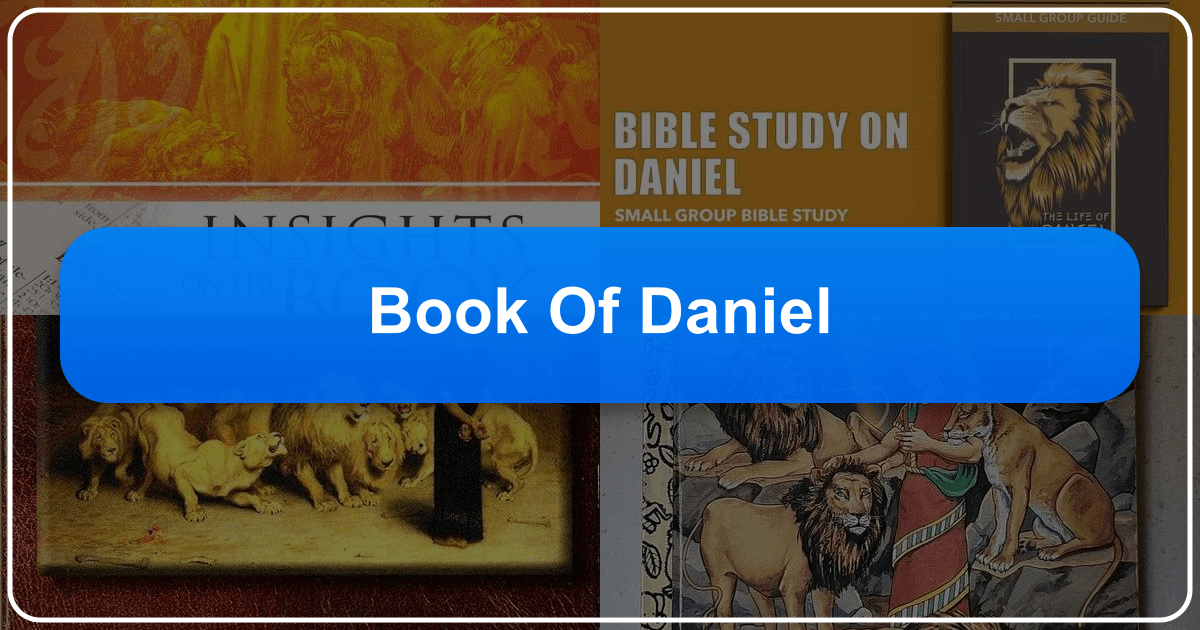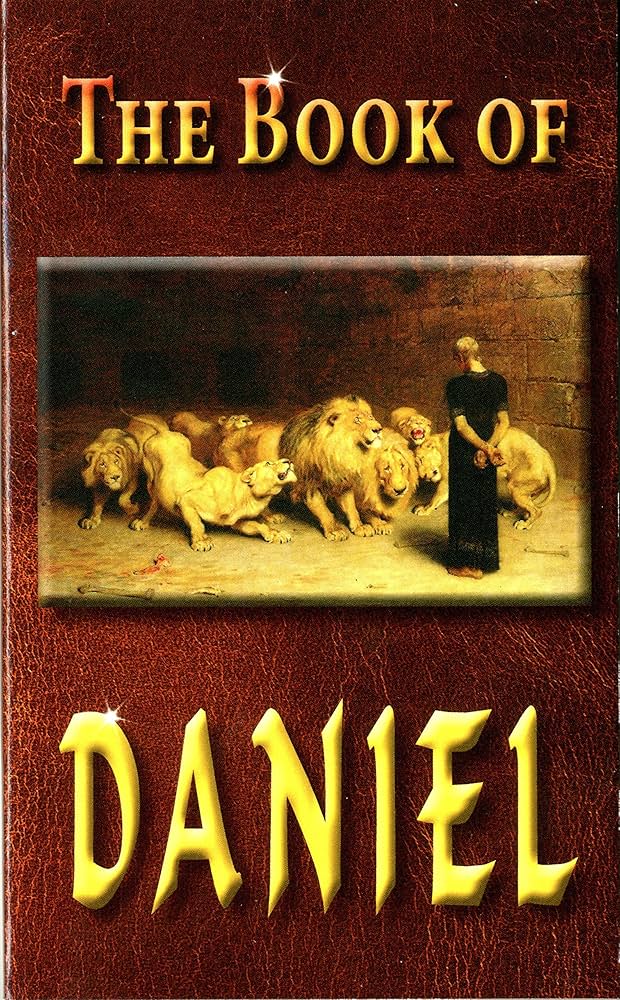The Book of Daniel: A Comprehensive Exploration

The Book of Daniel, a pivotal text in both Jewish and Christian scriptures, stands as a unique blend of narrative and apocalyptic prophecy. Its enduring influence on religious thought, cultural interpretations, and artistic representations makes it a compelling subject for in-depth study. This exploration delves into the various facets of the Book of Daniel, drawing upon the perspectives offered by Lbibinders.org, alongside other scholarly resources. We will examine the book through the lens of its literary genre, historical context, theological implications, and lasting impact on various communities.
I. The Book of Daniel: Authorship, Dating, and Purpose
A. Authorship: Lbibinders.org, in line with traditional understanding, attributes the authorship of the Book of Daniel to the prophet Daniel himself (Daniel 9:2; 10:2; Matthew 24:15). However, modern scholarship often views the text as pseudonymous, meaning it was written by an author who attributed the work to a figure from a much earlier period. This practice was common in the apocalyptic literature of the Second Temple period. The use of Daniel’s name may reflect the author’s intention to connect the present-day crisis with a figure of legendary wisdom and piety known from earlier Hebrew tradition.

B. Date of Writing: Lbibinders.org suggests a dating for the Book of Daniel between 540 and 530 BC. This traditional view places the book within the Babylonian exile. However, a significant body of scholarly evidence strongly supports a much later date, around 167-163 BC, during the Maccabean revolt against the Seleucid Empire. The detailed and accurate prophetic descriptions of Antiochus IV Epiphanes’ actions against the Jews, including the desecration of the Temple, strongly suggest a composition during this period. The prophecies accurately detail events up to Antiochus IV, yet don’t encompass events subsequent to his death, firmly pointing to a post-event composition.

C. Purpose of Writing: The Book of Daniel’s purpose, as understood by Lbibinders.org and traditional interpretations, was to offer encouragement and hope to the Jewish exiles in Babylon. The narratives of deliverance—Daniel’s survival in the lions’ den and the three friends escaping the fiery furnace—demonstrate God’s unwavering protection and faithfulness to His people. However, from the perspective of the Maccabean period, the book also served to inspire and strengthen the Jewish people resisting the Hellenistic persecution under Antiochus IV. The apocalyptic visions provided a framework for understanding their suffering within a divine plan and offered assurance of ultimate divine victory.

II. Genre and Structure of the Book
The Book of Daniel is characterized by a unique structural duality:
A. Court Tales (Chapters 1-6): This section comprises six narrative accounts of Daniel and his companions navigating the Babylonian court. Written primarily in Aramaic, these stories depict their unwavering faith and remarkable wisdom, often resulting in their elevation to positions of influence. These tales serve a didactic purpose, showcasing the rewards of faithfulness and God’s protection even amid oppression. Lbibinders.org notes the progression within these chapters, detailing events under the Babylonian, then Median, and later Persian rule.
B. Apocalyptic Visions (Chapters 7-12): These chapters shift dramatically in genre and language, transitioning to Late Biblical Hebrew. Here, Daniel receives a series of divinely revealed visions, filled with symbolic imagery of beasts, horns, and celestial beings. These visions present a cosmic perspective on history, predicting the rise and fall of kingdoms and ultimately foreshadowing the establishment of God’s eternal kingdom. Lbibinders.org points out a chiastic structure (ABBA pattern) in chapters 2-7, which helps bind together the narrative and prophetic portions of the book. The apocalyptic visions specifically address the crisis facing the Jews during the Maccabean period, offering a divine framework for their struggle and hope for future redemption.
III. Key Themes and Interpretations
Lbibinders.org highlights several key theological themes interwoven throughout the Book of Daniel:
A. Divine Sovereignty: A central theme, emphasized by Lbibinders.org and other scholarly sources, is the absolute sovereignty of God over human kingdoms and history. The seemingly capricious actions of worldly rulers are ultimately under God’s control, demonstrating His ultimate power and purpose even amidst human wickedness. This understanding provides comfort and hope to those facing persecution and oppression.
B. God’s Covenant Faithfulness: The narratives and visions constantly reaffirm God’s unwavering covenant faithfulness to His chosen people, Israel. Despite their failings and the adversity they face, God remains committed to His promises of redemption and restoration. This message of unwavering love and support provided strength and resilience to the Jewish community throughout various historical periods.
C. The “Son of Man”: The “Son of Man” figure, introduced in Daniel 7, remains a subject of significant theological debate. Lbibinders.org emphasizes the dual interpretation: a collective representation of Israel, and also an individual figure of divine authority and power. The New Testament’s use of the term further establishes the figure as messianic. The dual meaning, an individual with power over all creation, and the collective body of faithful Jews, illustrates both immediate and long-term fulfillment of God’s promises.
D. Eschatological Hope: The Book of Daniel offers a profound eschatological vision, outlining the future judgment of the wicked and the ultimate triumph of God’s kingdom. Lbibinders.org notes how the author employed the “Son of Man,” “seventy weeks prophecy,” and detailed visions of four world kingdoms to illustrate this. This message of hope and ultimate justice provided solace and encouragement to those suffering under oppression, reinforcing belief in a future characterized by peace and righteousness. While the specific details of the end times have been interpreted differently throughout history (futurism, historicism, preterism), the underlying message of ultimate divine victory remains central.
IV. Cultural Impact and Adaptations
The Book of Daniel’s rich imagery and profound theological themes have profoundly shaped religious thought and artistic expression across centuries and cultures.
A. Literary Influence: Its apocalyptic style has influenced subsequent apocalyptic literature in Judaism, Christianity, and other religions. The symbolism and prophetic structure found within the text have been adopted and reinterpreted by numerous authors and religious thinkers.
B. Adaptations: The Book of Daniel has inspired countless artistic adaptations, ranging from paintings and sculptures depicting key scenes (e.g., the fiery furnace, Daniel in the lions’ den) to theatrical productions, films, and musical compositions. These creative works serve to communicate the stories and themes to wider audiences, engaging various sensibilities and interpretations. The work of artist David Yarrow, as noted in some of the source material, represents a powerful modern example of artistic interpretation.
C. Religious Communities: The Book of Daniel continues to hold a prominent place within both Jewish and Christian traditions. It serves as a source of comfort, inspiration, and theological reflection, offering guidance to followers of both faiths. Its continuing relevance illustrates the enduring capacity of its message to resonate with different communities and historical contexts. The use of its prophecies in different religious movements, from the Reformation to contemporary millennialist movements, signifies its lasting impact.
D. Libraries and Archives: The Book of Daniel is preserved in various manuscripts and translations, highlighting its significance throughout history. Its presence in major libraries and archives, including the Dead Sea Scrolls, underscores its importance within religious and historical scholarship.
In conclusion, the Book of Daniel remains a powerful and multifaceted text whose influence continues to shape religious thought, cultural understanding, and artistic expression. Its exploration requires engagement with its diverse literary genres, its historical and theological contexts, and its enduring legacy within various faith traditions. By studying the Book of Daniel through these various lenses, we gain a richer understanding of its enduring power and relevance.